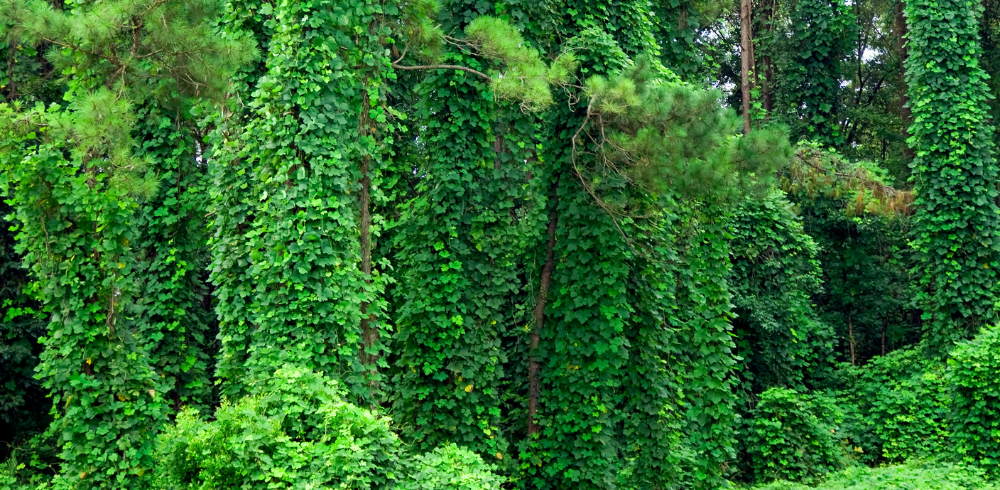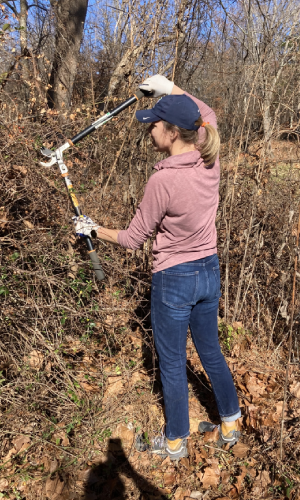What is an Invasive Species?
An invasive species is a term for a species that evolved in a different part of the world and was introduced into a new (non-native) environment. These species can be plants, animals, fungi, etc., but the types of invasive species that pose the largest threats to riparian buffers in our area are plants. There are numerous species of introduced vines, shrubs, and trees that have become invasive in Virginia.
Our local ecosystems are interconnected systems of species that evolved together over the course of millions of years. There are checks and balances in place to make sure that one species doesn’t overpower another. However, when a new species from outside the ecosystem is introduced, those checks and balances can be thrown out of whack and allow the invading plant to take over. Native animals do not recognize invasive plants and in many cases do not eat them, allowing the invasives to compete with native plants for access to sunlight and moisture. Some species like the Tree of Heaven (Ailanthus altissima) even produce a chemical in their roots, leaves and bark that can prevent other plants from getting established.

Have you ever been driving on the highway and seen a section of the forest that is completely covered by vines? This is becoming a more and more common sight in Virginia and beyond and there are cascading consequences to the explosive growth of these invasive species. The plant in this photo is called Kudzu (native to Japan and Southeast China). It has the ability to shade out everything from grasses to the tallest trees while providing very few benefits to native animals (it doesn’t provide shelter and is not the preferred meal for animals like deer). Other species like Asiatic bittersweet, Japanese honeysuckle, Porcelain berry, and more pose similar threats to biodiversity, especially in our riparian buffers.
How Does JRBP Address Invasives?
The team behind the James River Buffer Program (JRBP) knows how detrimental invasives can be to trees of all sizes and understands the importance of managing invasive plants around our buffer projects. Before a buffer is designed, a representative from the JRBP will visit the site to assess the pressure coming from invasives and then make a plan with the landowner to address them before planting. Under the JRBP invasive species management is covered only in the eligible buffer project areas defined by a JRBP representative. The timeframe we manage the invasive species in the buffer planting areas is from the site preparation phase through 3 years of establishment maintenance. However, depending on how the landowner would like to tackle invasive species on their property, there may be regular maintenance responsibilities that the landowner will need to take on.
If a site has intense pressure from vines and other harmful species, then large machinery like a forestry mulcher may be the solution. These machines look similar to skid steers and are able to target invasive trees, shrubs, and vines and grind them into a fine mulch. Forestry mulchers are incredibly efficient and can quickly break up a dense cluster of invasive plants.

For the many sites that are smaller or have less invasive pressure, invasive species can be controlled by hand. There are several ways to approach this, with the most common and effective methods employing the careful and targeted use of herbicides. JRBP recommends using herbicides because they greatly decrease the likelihood that the invasive plants will grow back. We work with contractors who are experienced Certified Pesticide Applicators in the state of Virginia and use herbicides that are aquatic safe.
In cases where herbicides are not used, invasive plants will need to be controlled by hand. There is a much higher chance of these plants growing back, and these properties will require more maintenance than the JRBP is able to provide. Landowners who wish to address invasives without the use of herbicides will need to take on some of the necessary management.
Next time you are taking a cruise down a backroad and see a buffer project, take a second and think about all the planning season that goes into planting season that JRA or any other organization puts into each new buffer site.

